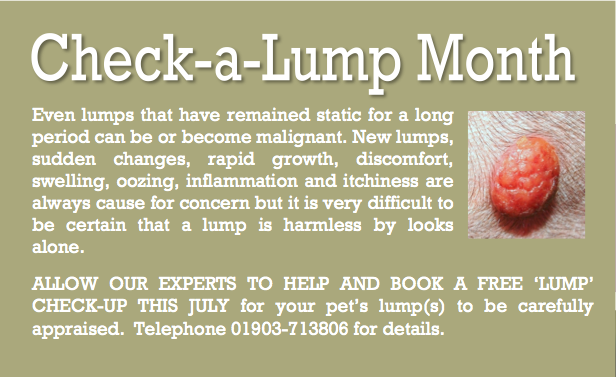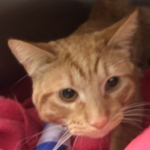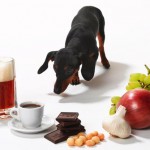Archive for August, 2014
by on August 4th, 2014
Category: Special Offers, Tags:

by on August 4th, 2014
Category: Pet of the Month, Tags:
 It is very unusual for cats to swallow some of the more dramatic objects that dogs have been known to ingest. They are much more thorough than dogs in their appraisal of unusual ‘food’ items and very selective about what will pass their lips. It was therefore with great surprise that we discovered a nail to be the cause of Jack’s vomiting. He had been off colour for a few days and when Jack failed to respond to treatment we radiographed his abdomen. The offending object was immediately identified and swiftly removed. We are delighted to say that Jack, who has been an exemplary patient, is making excellent progress.
It is very unusual for cats to swallow some of the more dramatic objects that dogs have been known to ingest. They are much more thorough than dogs in their appraisal of unusual ‘food’ items and very selective about what will pass their lips. It was therefore with great surprise that we discovered a nail to be the cause of Jack’s vomiting. He had been off colour for a few days and when Jack failed to respond to treatment we radiographed his abdomen. The offending object was immediately identified and swiftly removed. We are delighted to say that Jack, who has been an exemplary patient, is making excellent progress.
by on August 4th, 2014
Category: News, Tags:
 The most unexpected things around the home and garden can present a hazard to your pets. This week we look at ten unexpected dangers you might not have been aware of. Prevention is better than cure – if you can, always ensure that potential hazards are kept securely away from your animals, and take what steps you can to prevent exposure. If you suspect your pet may have eaten or encountered any of the hazards discussed in this newsletter, contact your vets straight away for advice and appropriate treatment; do this even if your pet seems completely well, as with many of these dangers, there can be a delay of hours to days before signs of illness become apparent. Starting treatment before the pet starts to appear unwell can significantly improve the odds of them making a full recovery.
The most unexpected things around the home and garden can present a hazard to your pets. This week we look at ten unexpected dangers you might not have been aware of. Prevention is better than cure – if you can, always ensure that potential hazards are kept securely away from your animals, and take what steps you can to prevent exposure. If you suspect your pet may have eaten or encountered any of the hazards discussed in this newsletter, contact your vets straight away for advice and appropriate treatment; do this even if your pet seems completely well, as with many of these dangers, there can be a delay of hours to days before signs of illness become apparent. Starting treatment before the pet starts to appear unwell can significantly improve the odds of them making a full recovery.
Raisins
Raisins contain an as-yet unidentified substance which can in some cases cause acute renal (kidney) failure in dogs. And it’s not just raisins, but currants, sultanas, and even fresh grapes, too.
Raisins and grapes are a rather unusual poison, as some dogs seem to be able to eat them quite safely – whereas other dogs can develop life-threatening acute kidney failure; as few as four or five grapes are believed to have resulted in one dog’s death. The mechanism of the toxic effect is still unknown, and since there’s no way of really knowing whether your dog is going to be one of the unlucky ones, it’s best to make sure they never eat any kind of grapes, raisins, or other dried vine fruits – whether they’re raw, or prepared in cakes, puddings or other cooking. Christmas, with its proliferation of mince pies, Christmas pudding and other seasonal treats, is a particularly high risk time of year!
Painkillers
Just about all of us have a pack of Paracetamol, Ibuprofen, or Asprin somewhere around the house (and often in our handbags, too!). While they are freely available without prescription, and very widely used by people, all of these medicines (from a family known as the non-steroidal anti-inflammatory drugs) have the potential to cause illness in our pets, sometimes even after only a very tiny dose.
The toxic effects can vary quite widely depending on the drug taken, and the species of animal, and include the potential development of stomach ulcers, liver and kidney damage, and also abnormalities affecting the blood. Confusingly, these medicines are sometimes used intentionally in dogs and cats by veterinary surgeons – they can be very useful, powerful drugs, if used carefully and in appropriate patients. If you ever find a chewed up pill packet (whether it contained over the counter painkillers, or any other medication) contact your veterinary surgery ASAP for advice.
Cut flowers
All the parts of lily plants (including the pollen which is present on the stamens of lilies in cut flower arrangements) are highly poisonous to cats, with the potential to cause life threatening kidney failure. Cats can be harmed even as a result of swallowing pollen which has transferred to their fur while walking past flowering lilies, or from chewing leaves or flowers, either from flower arrangements, or from plants growing outdoors in gardens
Fortunately general awareness of this problem is now growing, and cut flower arrangements containing lilies – particularly those from larger retailers – are starting to carry warning labels. Plants and cut flowers from the Lilium and Hemerocallis species are most hazardous, though other lily-type flowers (including lily-of-the-valley) also present a variety of different toxic hazards.
Bread dough
Bread dough is an occasional cause of serious illness and can affect all species, though dogs, due to their tendencies to eat all kinds of things, are most often affected. Dough containing live yeasts will continue to ‘rise’ (that’s to say increase in volume) inside the dog’s stomach, which is at more or less a perfect temperature! Because of the elastic, springy nature of rising bread dough, it tends to stay in a large ball and is extremely difficult for the dog to vomit up or to pass further down the digestive tract.
As the ball of dough swells, it stretches the stomach wall, causing pain, and serious damage to the tissue as a result of the blood supply being compromised – very much as happens during the life-threatening condition GDV (gastric dilatation and volvulus, or ‘bloat’). As if this wasn’t bad enough, the yeasts also produce alcohol (ethanol) as a by-product of their fermentation, and this can be enough to cause symptoms of alcohol toxicosis. So, keen bakers among you, keep your rising dough and proving loaves safely out of reach of your pets!
Certain over-the-counter flea products
A number of over-the-counter flea spot-on products marketed for dogs in the UK and elsewhere in the world contain an active ingredient from the pyrethrin or pyrethroid family (most commonly ‘permethrin’). While these are generally well tolerated by dogs, the concentration of active ingredient in these products can potentially make for a lethal dose for a cat, whether the product itself is accidentally applied to the cat in error, or even due to cats snuggling up to recently treated dogs in the household and the product rubbing onto them.
Cats exposed to permethrin develop twitches and muscle tremors which can progress to epileptic-type fits if the drug passes into their brain and central nervous system in a high enough concentration. These seizures can sometimes be fatal. To be on the safe side, contact your veterinary surgery for advice on appropriate safe flea products for your whole household.
Needles & threads
Most cats just can’t resist string or thread, which is a habit that can get them into trouble! Playing can sometimes lead to biting and swallowing, and swallowing string (or sewing thread, knitting yarn, ribbon, tinsel…) can cause a very serious form of foreign body obstruction in the gastrointestinal tract, which can require extensive surgery to resolve, and can sadly sometimes lead to the death of the patient. Unfortunately, sometimes the threads that cats find have sewing needles on the end of them, which can complicate matters further, increasing the risk of gut perforation and problems associated with needle migration. Kittens, who are particularly inquisitive and playful, are especially at risk, so keep your needles and threads safely locked away!
Corn on the cob
Dogs seem to love to chew on these, and if they swallow a piece, corn cobs seem to be almost the perfect size to cause an obstruction in the intestines. Unlike some of the other unfortunate non-food items our dogs like to chew on and sometimes swallow, corn cobs are essentially invisible on x-ray, which can make the process of identifying and diagnosing the foreign body obstruction even more challenging than usual for veterinary staff.
Classic opportunities for dogs eating corn cobs are at summer family BBQs – other BBQ party hazards include cooked bones, and kebab sticks – and scavenging in bins. Yet another reason to ask visitors to your home not to feed your dogs tit-bits, and keep your kitchen waste secure until bin day!
Cement powder
Powdered cement and concrete, both before use, and the dust produced from cutting or grinding solid materials, can pose a serious hazard to fish and waterways. Cement powder is a strong alkali, and when added to water can raise the pH very substantially, exposing any animals in that water to the risk of what are, essentially, chemical burns. In addition, the fine powder easily clogs the gills of fish, and can suffocate them rapidly.
If you’re having building work (or there is some going on nearby) it’s really important to cover and protect both outdoor ponds and indoor fish tanks if there is any risk of cement or concrete debris contaminating them. And, since many surface water drains flush into waterways with minimal water treatment, anyone working with cement or concrete should avoid washing any wastes ‘away’ into surface drainage, as dilution does very little to reduce the hazard, and serious damage can be caused to river and lake ecosystems as a result of cement and concrete run-off.
Antifreeze
Vehicle antifreeze (ethylene glycol) can cause poisoning in all animals, but most commonly affects dogs and cats. Ethylene glycol tastes sweet, which is attractive to pets, and unfortunately vehicle antifreeze is often stored very insecurely in sheds and garages, and not cleared up carefully after accidental spills or leaks from car radiators. The lethal dose of undiluted antifreeze solution in a cat could be as little as a teaspoon.
Symptoms initially resemble drunkenness, with balance and movement abnormalities, and often vomiting. As the ethylene glycol is metabolised in the body, substances are created which cause serious and irreversible damage to the tissues of the kidneys, resulting in rapid kidney failure. Pets who have consumed antifreeze unfortunately often do not survive, but time is of the essence and the sooner treatment is started the better the odds. So check around your home, and any sheds, garages and outbuildings for antifreeze and make sure it is stored correctly, and if you ever suspect antifreeze poisoning in your pets, act fast.
Curtains
It is common, particularly in more expensive hand-made curtains, to use small weights, either in the corners of the bottom hem, or all along the bottom hem, to help the curtains hang nicely. These weights are still very often made of lead.
These little nuggets can look like an object of interest to small mammals – including rabbits – and pet birds, especially parrots with their inquisitive natures, to whom they resemble nuts or seeds. If swallowed, they can cause lead poisoning. The other common cause of accidental lead poisoning in small pets and birds is the use of previously painted wood to make hutches, runs, and similar structures – if this wood is old enough to have been treated with lead paint in the past, very little may be required to cause serious health problems.
 It is very unusual for cats to swallow some of the more dramatic objects that dogs have been known to ingest. They are much more thorough than dogs in their appraisal of unusual ‘food’ items and very selective about what will pass their lips. It was therefore with great surprise that we discovered a nail to be the cause of Jack’s vomiting. He had been off colour for a few days and when Jack failed to respond to treatment we radiographed his abdomen. The offending object was immediately identified and swiftly removed. We are delighted to say that Jack, who has been an exemplary patient, is making excellent progress.
It is very unusual for cats to swallow some of the more dramatic objects that dogs have been known to ingest. They are much more thorough than dogs in their appraisal of unusual ‘food’ items and very selective about what will pass their lips. It was therefore with great surprise that we discovered a nail to be the cause of Jack’s vomiting. He had been off colour for a few days and when Jack failed to respond to treatment we radiographed his abdomen. The offending object was immediately identified and swiftly removed. We are delighted to say that Jack, who has been an exemplary patient, is making excellent progress. The most unexpected things around the home and garden can present a hazard to your pets. This week we look at ten unexpected dangers you might not have been aware of. Prevention is better than cure – if you can, always ensure that potential hazards are kept securely away from your animals, and take what steps you can to prevent exposure. If you suspect your pet may have eaten or encountered any of the hazards discussed in this newsletter, contact your vets straight away for advice and appropriate treatment; do this even if your pet seems completely well, as with many of these dangers, there can be a delay of hours to days before signs of illness become apparent. Starting treatment before the pet starts to appear unwell can significantly improve the odds of them making a full recovery.
The most unexpected things around the home and garden can present a hazard to your pets. This week we look at ten unexpected dangers you might not have been aware of. Prevention is better than cure – if you can, always ensure that potential hazards are kept securely away from your animals, and take what steps you can to prevent exposure. If you suspect your pet may have eaten or encountered any of the hazards discussed in this newsletter, contact your vets straight away for advice and appropriate treatment; do this even if your pet seems completely well, as with many of these dangers, there can be a delay of hours to days before signs of illness become apparent. Starting treatment before the pet starts to appear unwell can significantly improve the odds of them making a full recovery.

